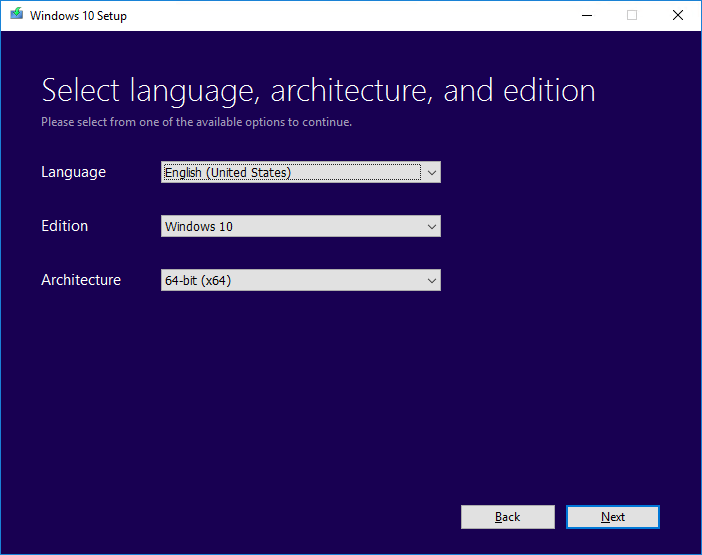Beginning with BatchPatch version 202004, Windows 10 ‘feature upgrades’ or ‘feature updates’ such as 1607, 1703, 1709, 1803, 1809, 1903, 1909, 2004, 20H2, 21H1, 21H2 etc can all be installed with the normal Windows Update actions in BatchPatch (you must disable cached mode and also check the ‘Upgrades’ classification under ‘Tools > Settings > Windows Update‘). However, the alternate Windows 10 feature update deployment method outlined below can be used with any version of BatchPatch.
- Use the Windows 10 Media Creation Tool to obtain the ISO installation media for the version of Windows 10 that you want to deploy. You can download the Windows 10 Media Creation Tool directly from Microsoft at this link. It will enable you to obtain the most recent version of Windows 10, which at the time of this writing is version 1709. You cannot use this tool to obtain anything other than the current/latest version, so if you are needing an older version then you would have to obtain it through some other means, such as through a volume licensing agreement with Microsoft.
- Run the media creation tool. When you run the media creation tool you *must* be logged on to the computer as a local administrator. It is *not* sufficient to use ‘run as’ to run the tool with elevation as an administrator. You must actually be logged-on to the computer as the administrator before you run the media creation tool, otherwise the tool will not let you proceed.
- Create installation media. When you run the media creation tool you will have the option to either Upgrade this PC now or Create installation media (USB flash drive, DVD, or ISO file) for another PC. Select the option to Create installation media, and then click Next.

- Choose the language, the edition, and the architecture when prompted, and then click Next again.

- Select destination media type. The media creation tool gives you the option of putting the installation files on a USB flash drive or into a single ISO file. For this tutorial please choose ISO, and then click Next. You will be prompted for a location on disk to save the ISO file. Choose a file destination and wait for the download to complete.

- Extract ISO contents. After the ISO download has completed, extract the contents of the ISO file to a new directory on your computer. While you can use almost any extraction tool for this process, I prefer and recommend 7-zip, which is available for free. After the extraction is complete you will have a folder that contains all of the required installation files.

- Create the BatchPatch deployment. Select Actions > Deploy > Create/modify. In the Deployment interface, select the setup.exe (from the extracted contents of the ISO) as the file to deploy, and make sure to check the ‘Copy entire directory‘ box and the ‘Leave entire directory‘ box, so that when the target computer is rebooted multiple times during the upgrade/installation, it still has access to all of the files required for the upgrade. ( After the upgrade is complete you may delete the files, but just please make sure that you don’t delete them while the upgrade is still working. Also note, the target computer will reboot multiple times during the upgrade before it’s complete. ) In your deployment configuration you will additionally need to add the following parameters:
/auto upgrade /quiet
- Execute the deployment. When you are ready you can either save the deployment to execute later by using the double-right-arrow ‘>>’ button, or you can execute the deployment now for the currently selected rows in the BatchPatch grid by clicking the Execute now button. The deployment will take some time because BatchPatch has to copy multiple GBs of data to the target computers before it can execute the upgrade. When BatchPatch shows Exit Code: 0 (SUCCESS) for a given target computer you should expect that the target will still be working and will still reboot at least one time but possibly multiple times while Windows is upgraded and configured on the target, so be patient and let it do its thing!
NOTE: We have had two reports where a user received the following error:
Deployment: Error: Access to the path '\\TargetComputer\C$\Program Files\BatchPatch\deployment\autorun.inf' is denied.
It’s unclear why these two users experienced this error while many others, including us, have executed the deployment successfully without encountering the error. My guess is it might have something to do with the application used to extract the .ISO file. Nonetheless, if you encounter the error it can be resolved by simply deleting the autorun.inf file from the source directory before beginning the deployment.


